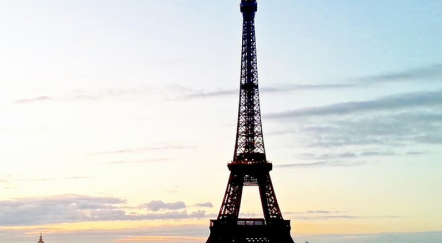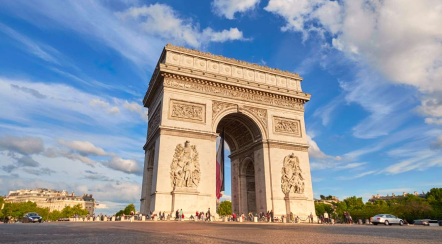< Back to monuments

The Louvre 
The Louvre, opened in 1793, is one of the most famous art museums in the world.
It is part of Paris Historical Axis (or “royal road”), composed, from east to west, by the Louvre, Louis XIV equestrian statue, the Tuileries Garden, the Concorde Obelisk, the avenue des Champs-Elysées, the Arc of Triomphe and the Great Arche at la Défense.
In addition to having an impressive art collection, the Louvre is also a building steeped in history to discover in the heart of Paris.
Official website: https://www.louvre.fr/
Timetables and acces
The Louvre is open from Wednesday to Monday from 9:00 a.m. to 6:00 p.m. (Monday, Wednesday, Thursday, Saturday and Sunday) or from 9:00 a.m. to 9:45 p.m. (Friday). The museum is closed on Tuesday.
Exceptionnal closings: 01/01, 05/01 and 12/25 (month/day).
The Louvre museum is located in the heart of Paris, in the 1st district, Rue de Rivoli, 75001 Paris.
The site is reachable by public transport:
- Metro : lines 1 and 7 “Palais Royal / Musée du Louvre” station or lines 14 and 7 “Pyramides” station.
- Bus : lines 21 “Palais Royal Musée du Louvre” stop, 27 “Musée du Louvre” stop, 39 “Musée du Louvre” stop, 68 “Musée du Louvre” stop, 69 “Musée du Louvre” stop, 72 “Palais Royal Musée du Louvre” stop, 81 “Palais Royal Musée du Louvre” stop, 95 “Musée du Louvre” stop or Batobus.
Paying car park is located near the museum, avenue du Général-Lemonnier, 75001 Paris (7 a.m. to 11 p.m.).
The Louvre main entrance is located in the Pyramid, in the center of the Cour Napoléon, but visitors can also take the Carrousel underground passage to reach the Pyramid.
Four lines are planned to welcome visitors:
– Yellow: Visitors without ticket.
– Orange: Visitors with tickets.
– Green : Visitors with tickets with specified time.
– Blue : People with reduced mobility, pregnant women, strollers, hard of hearing and visually impared persons.
To avoid the crowd, it is better to enter the museum by the Carrousel underground passage.
The Louvre visit is the opportunity to discover the Tuileries garden laid out by André le Nôtre (King Louis XIV gardener) which links the Louvre museum to the Place de la Concorde.
The garden is free
Price
Onsite ticket: €22
Online ticket (with specified time): €22
Free access under conditions, consult the official website.
The tickets give access to the various museum collections as well as to temporary exhibitions (validity time: 24h) and to the Eugène-Delacroix museum (validity time: 48h). They are only valid for the date and time indicated.
Audioguides can be rented to accompany the visit (€6).
Museum plans are available under the Pyramid.
Various workshops and guided tours are also offered by the Louvre museum (more information here).
Group visits (limited to 25 participants) can be booked online.
Tickets can be purchased online here or by phone at +33(0) 1 40 20 55 00 (payment by credit card only).
Please note: a room opening calendar is available on the official website and allow checking rooms opening before visit. Due to the size of its collections and works movements, the museum cannot guarantee the permanent and simultaneous opening of all its rooms
To save time and be sure of having access to the museum, buy your tickets before coming and book the time of your choice.
The first Saturday of each month, the Louvre is open to everyone for free from 6:00 p.m. to 9:45 p.m. The museum is also open for free on July 14 (French National Day).
To avoid the crowds, prefer early morning or late night visits. The night tours avoid the crowds and are occasions to enjoy the Cour Napoléon and Pyramid lightning.
Accessibility
Access to the Louvre museum is possible for people with reduced mobility.
Metro station “Pyramides” is accessible to people with reduced mobility. Parking spaces are available at a reduced rate in the Louvre Carrousel shopping mall car park (1 avenue du Général-Lemonnier, 75001 Paris). Go to the “Assistance” service to get your parking ticket stamp and to obtain the reduction.
People with reduced mobility and accompanying person have free access to the museum.
Themed routes optimized to reduce elevators number to use are offered on the museum official website.
Wheelchairs, folding chairs and rubber tips canes are allowed in the museum or can be borrowed free of charge at the “Assistance” service. Metal tips canes are not allowed in the museum.
To check the various exhibitions accessibility with these materials, contact the museum by email (handicap@louvre.fr) or by phone (+33(0) 1 40 20 53 17).
All the museum toilets are equipped to accommodate people with reduced mobility.
Guide dog and optical aids are allowed for visually impaired or blind people. “A
museum open to all” brochure is available on request from the Information service and contains four parts in Braile.
For hearing impaired people with hearing aids, magnetic loops are installed under the Pyramida at the level of the Information service, at automatic pay stations, at the group reception, at the “Assistance” service and in the auditorium. The museum also offers a tour compatible with magnetic loops on the Nitendo 3DSTM audioguide.
Museum staff can accompany visitors with reducerd mobility or with disabilities from the Information service (museum reception) to the various museum rooms, to the car park or to the metro station.
Pages dedicated to accessibility conditions for visitors with disabilities are available on the official website.
Toilets
Several toilets are available in th museum, under the Pyramid and in the different building wings
To avoid crowds and enjoy cleaner toilets, prefer those inside the museum rather than those of the Pyramid.
Pets
Please note: Dogs and other pets are not allowed on site.
Only guide dogs are allowed to access the monument.
Vigipirate
As part of Vigipirate operation (see NEED TO KNOW), security check will be carried out when entering the site.
Maximum luggages size authorized: 55 cm x 35 cm x 20 cm. The museum offers a free cloakroom and locker service for below limit size luggages and for umbrellas.
It is strictly forbidden to smoke, to drink, to eat, to speak loudly, to touch the works and to run in the Louvre museum.
Shops and restaurants
Several shops and bookstores are available at the Louvre. They offer a wide choice of books, works of art, visiting materials and gifts
A set of cafes, restaurants and take-away points of sale are available on the Louvre site to eat and drink
Photos
Photos without flash and videos are authorized in the permanent collections rooms.
Photos and videos are prohibited in temporary exhibition rooms.
Tips :
The Richelieu passage offers a beautiful perspective on the Pyramid and the Louvre on the background, especially at the end of the day. It is also possible to photograph the Pyramid with the Louvre in the background from the Tuileries Garden.
WIFI
A free WiFi hotspot (Louvre_Wifi_gratuit) is available under the Pyramid and in the museum. The connection lasts 1h and is renewable without limitation.
Take care
As for all major tourist sites, there is a risk of pickpockets presence around the Louvre museum. Watch your personnal belongings.
Please note: People sometimes try to sell ticket on the Louvre esplanade, but they are more expensive and sometimes not even valid! To avoid these inconveniences, tickets must be purchased using official ways (onlinre, ticket machines ou ticket offices).
Do you know?
The Louvre was originally a fortress dating from 1190. It was transformed into a residence during the Renaissance (from 1546) and then into a museum. The Louvre was notably Louis XIV royal residence.
The first name of the Louvre museum was the “Central Museum of the Republic Arts”.
Among the major exhibited works in the Louvre are La Joconde (Leonardo da Vinci), the Venus de Milo, the Crouching Scribe, the Victory of de Samothrace and the Code of Hammurabi.
Leonardo da Vinci’s Joconde was stolen from the museum in 1911 by Vicenzo Peruggia, but the latter was denounce and Mona Lisa returned to the Louvre in 1914.
Mona Lisa is famous for the complexity of its expression. Indeed, its gaze seems to follow the viewer.
The Louvre Pyramid, designed by architect leoh Ming Pei, was inaugurated in 1989.
The Louvre museum has many different art collections such as oriental antiques, Egyptian antiques, Greek, Etruscan and Roman antiques, Islamic arts, paintings, sculptures, art objects and graphical arts.
If you like numbers
With an area of 360,000 m², including 78,735 m² of galleries divided into 403 exhibition halls and 14.5 km of corridors, the Louvre is the largest museum of art and antiques worldwide.
In total, there are 4 glass pyramids in the Cour Napoléon. The main Louvre Pyramid is 21 meters high and weighs 200 tonnes. It consists of 673 glass plates.
The Louvre owned 554,731 objects in 2016, including graphic works. Among them, around 35,000 works are exhibited in the galleries.
Approximately 96 hours, or 4 full days, would be necessary to visit the entire museum spending 10 seconds in front of each work.
The museum is managed by 2091 employees.
The largest work exhibited at the Louvre, Les Noces de Cana (by Véronèse), covers 67 m².
The oldest work owned by the Louvre is Aïn Ghazal statue, which is over 9,000 years old.
The Mona Lisa by Leonardo da Vinci receives more than 20,000 admirers per day. Great by its fame, Mona Lisa measures nevertheless “only” 77 cm by 53 cm.
The Louvre museum welcomes more than 10 million visitors each year, making it the most visited museum worldwide and the most visited cultural site in France
Air conditionned - Heated
The Louvre museum is heated in winter and air-conditioned in summer.
The museum being very large, bring confortable shoes to enjoy your visit. Spaces are provided in the museum to allow breaks and to rest during the visit.




